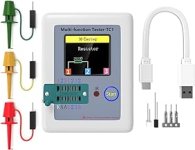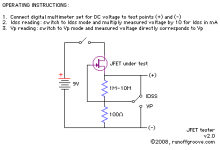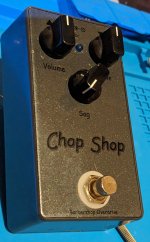I went the SMD + TO92 board route with this one as I read that J201 idss is critical for getting the FETs biased. I ordered 10 MMBFJ201 from Tayda at 42 cents each and 9 TO92 boards from Osh at $1.40 total (including shipping !!).
Soldering SMD was a new experience so it took a while but after nearly 2 hours I had 8 FETs mounted and leads added. I tested them using my new electronics tester (one of these):


It identified all the FETS as FETS (two needed remedial soldering) but idss range was 99uA-300uA, which was no good for the Chop Shop. I figured that the problem might be the tester so I built the simple test circuit (above) where you measure voltage across 100R resistor then multiply it by 100 to get idss in amps (for J201 you can also use 1k and multiply by 1k). Note that with that circuit if you only want idss then you can leave out the larger resistor and the switch and just have the drain and gate connected to the 100R. Measuring voltages across the 100R and doing the 100x math gave me a bunch in 600-700uA range and a few under 600uA. That allowed me to select a 650uA one for Q1 and a 550uA one for Q2.
Aside from all that the pedal was an easy build and the bias came in at 6V no problem. Here are the results.


I played it into a plexi-like amp last night; the sag worked well throughout the range of the knob and delivered an effect similar to old recordings of guitar from the 60s where you can hear the amps buckling under the load - nice! The drive is ok, nothing too special there, but I expect it would sound better into a clean Fender or similar.
I hooked it up to an 18V supply to see if that made a difference and it did - sag did nothing until almost full on, and the drive seemed weaker also. As you might expect, I guess. I will use it at 9V.
Soldering SMD was a new experience so it took a while but after nearly 2 hours I had 8 FETs mounted and leads added. I tested them using my new electronics tester (one of these):


It identified all the FETS as FETS (two needed remedial soldering) but idss range was 99uA-300uA, which was no good for the Chop Shop. I figured that the problem might be the tester so I built the simple test circuit (above) where you measure voltage across 100R resistor then multiply it by 100 to get idss in amps (for J201 you can also use 1k and multiply by 1k). Note that with that circuit if you only want idss then you can leave out the larger resistor and the switch and just have the drain and gate connected to the 100R. Measuring voltages across the 100R and doing the 100x math gave me a bunch in 600-700uA range and a few under 600uA. That allowed me to select a 650uA one for Q1 and a 550uA one for Q2.
Aside from all that the pedal was an easy build and the bias came in at 6V no problem. Here are the results.


I played it into a plexi-like amp last night; the sag worked well throughout the range of the knob and delivered an effect similar to old recordings of guitar from the 60s where you can hear the amps buckling under the load - nice! The drive is ok, nothing too special there, but I expect it would sound better into a clean Fender or similar.
I hooked it up to an 18V supply to see if that made a difference and it did - sag did nothing until almost full on, and the drive seemed weaker also. As you might expect, I guess. I will use it at 9V.
Last edited:

